Outdoor spaces are increasingly treated as extensions of our living areas. Whether it’s a covered patio, pergola, balcony, or poolside lounge, adding a designer outdoor fan does more than move air: it enhances the ambiance, complements architectural style, and allows comfort in warm weather. Unlike basic fans, designer outdoor fans emphasize aesthetics—high‑quality finishes, elegant blade styles, lighting features, and modern controls—while still being built to endure outdoor conditions like moisture, heat, rain, or even wind.
Durability is essential outdoors. The best designer outdoor fans feature motors rated for damp or wet environment, blades resistant to warping or corrosion, and finishes that won’t fade quickly under sun exposure. When you get all of that, you don’t just buy a fan—you buy a statement piece that works reliably, season after season. For many homes, the fan becomes both functional and decorative: it cools people, discourages bugs, adds lighting, and enhances outdoor living space appeal.
Key features to look for in designer outdoor fans
When identifying high‑quality designer outdoor fans, several technical and aesthetic attributes matter. First, check for the environmental rating: wet‑rated fans can safely be exposed directly to rain, while damp‑rated or covered outdoor fans are meant for protected areas. Then consider the motor type: DC motors are more efficient, quieter, and often more durable than basic AC motors. Blade material and finish are also critical—materials like powder‑coated metal, treated hardwood or synthetic composite resist rust or warping.
Lighting and controls add both style and convenience. Integrated LED light kits, multiple speed settings, remote controls, and smart‑home compatibility (voice control, wall‑mounted or phone app) elevate the user experience. Design‑wise, look at blade count and style (three, four, five blades; sleek minimal‑blade vs. tropical palm‑leaf shapes), color/finish matching your exterior décor, fan reach (blade span), and profile (how low the fan hangs). These features together define the “designer” aspect that sets premium models apart.
Benefits of using designer outdoor fans
Outdoor comfort enhancement
A designer outdoor fan significantly improves comfort in hot and humid weather. The constant airflow helps reduce perceived temperature by causing evaporative cooling on skin. Sitting outside on a deck or patio becomes more enjoyable even during peak heat. It also helps in humid climates by circulating air so moisture doesn’t stagnate, which can reduce discomfort and mildew.
Energy savings & environmental benefits
Using an outdoor fan consumes far less electricity than air conditioning units while still providing cooling effect. Modern fans with efficient motors and LED lighting draw minimal power. Some designer fans also offer features like multiple speed settings, timer functions, or smart control to avoid waste. Over time, this means lower electricity bills and a smaller carbon footprint.
Pest deterrence and improved air quality
Moving air discourages bugs—mosquitoes, flies, and other insects have difficulty flying in strong breezes. Thus fans can reduce insect annoyance without chemicals. Additionally, fans help reduce airborne irritants (e.g. mould spores, pollen) by keeping air moving rather than letting it become stagnant in partially enclosed outdoor spaces. This results in fresher air and healthier outdoor relaxation.
Aesthetic and design value
A high‑end designer fan isn’t just functional. It can be a focal point: matching your architectural style (tropical, modern, rustic, industrial), using premium materials (metal, hardwood, designer finishes), and sometimes even adding artistic flair (leaf‑shape blades, sculptural profiles). This aesthetic value adds to home resale, ambiance, and your satisfaction. It’s about marrying form and function.
Real‑world examples: top designer outdoor fans you can buy now
Here are several real designer outdoor fan models, with details about their construction, design features, and why someone might choose each. These help illustrate what to expect when buying, and which model might fit your specific needs.
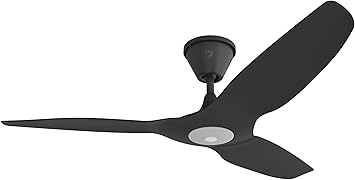
Big Ass Fans Haiku Coastal 52‑in Marine Grade Smart Outdoor Ceiling Fan
This is a premium marine/coastal‑grade fan. The blades are made of high‑performance material that resists salt air and corrosion, and the mounting and motor housing are sealed and coated to withstand ocean‑front conditions. It includes a dimmable LED light (2700 K), a matte white finish, and smart controls. Because of its quality, this fan is quieter than many lower‑end models, and it maintains performance in harsh weather with minimal maintenance. If you live near the sea, in high humidity, or want a very durable high‑end aesthetic, this model is ideal.
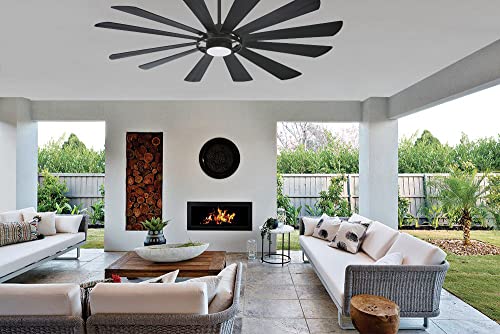
MINKA-AIRE Windmolen 65″ Outdoor Ceiling Fan with LED Light and Remote
Minka Aire Windmolen 65‑in Outdoor Ceiling Fan with LED Light and Remote
This large 65‑inch span fan delivers strong airflow, making it suitable for large patios or covered porches. The textured coal finish gives a stylish matte look; the included LED and remote control add convenience. Its size demands good ceiling height and proper clearance to avoid hazards. It’s perfect for open‑air structures or big entertaining spaces where design statement and performance go hand in hand.
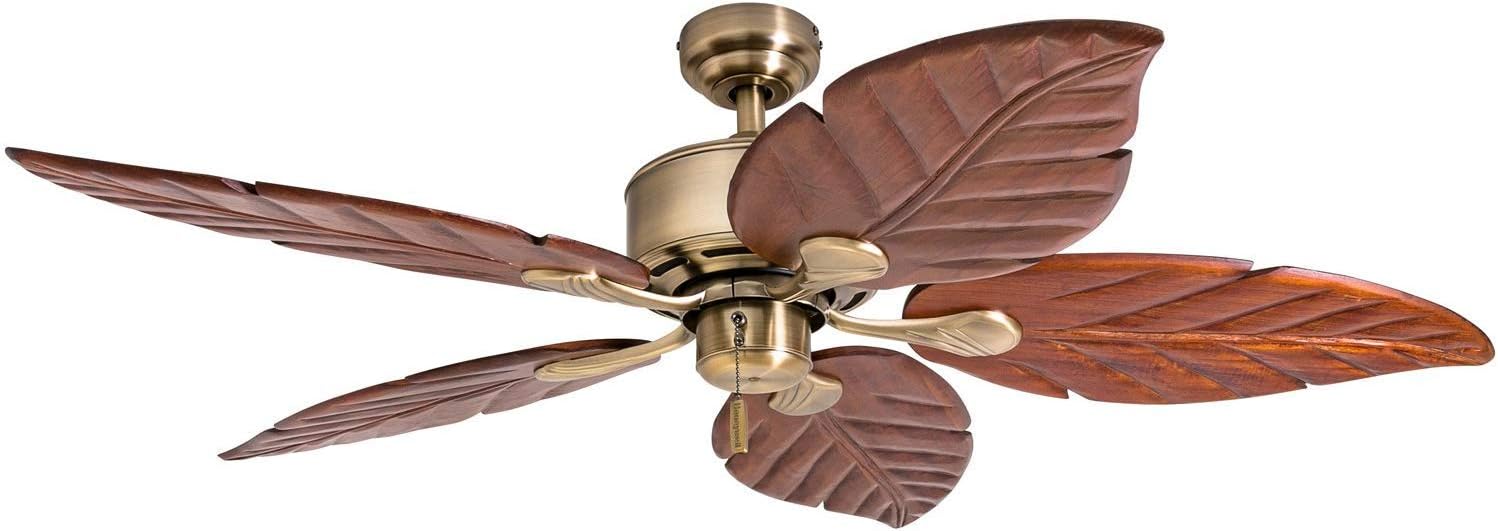
Honeywell Duvall Tropical Palm Leaf 52‑in Indoor/Outdoor Ceiling Fan
Stylized with palm‑leaf shaped blades, this fan brings a tropical, relaxed vibe. The bronze finish complements warm‑toned exteriors or tropical gardens. It’s rated for indoor/outdoor use, so usable in covered patios. Best suited to decorative outdoor spaces or resort‑style designs where style matters as much as airflow. It won’t handle direct rain unless certified for wet conditions, so it’s worth checking the specifications depending on installation type.
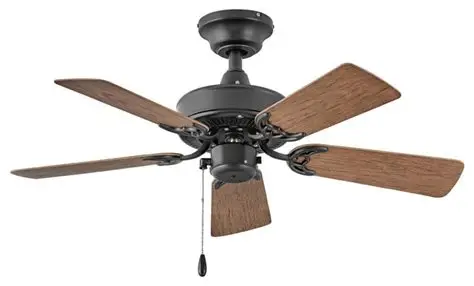
Hinkley Lighting Cabana Outdoor Ceiling Fan
This model has a style inspired by cabana / beachside architecture. The finish and blade style evoke coastal resort aesthetics. Often includes light kit and finishes that resist moisture. It’s suitable for mid‑sized covered outdoor spaces where you want something both decorative and functional.
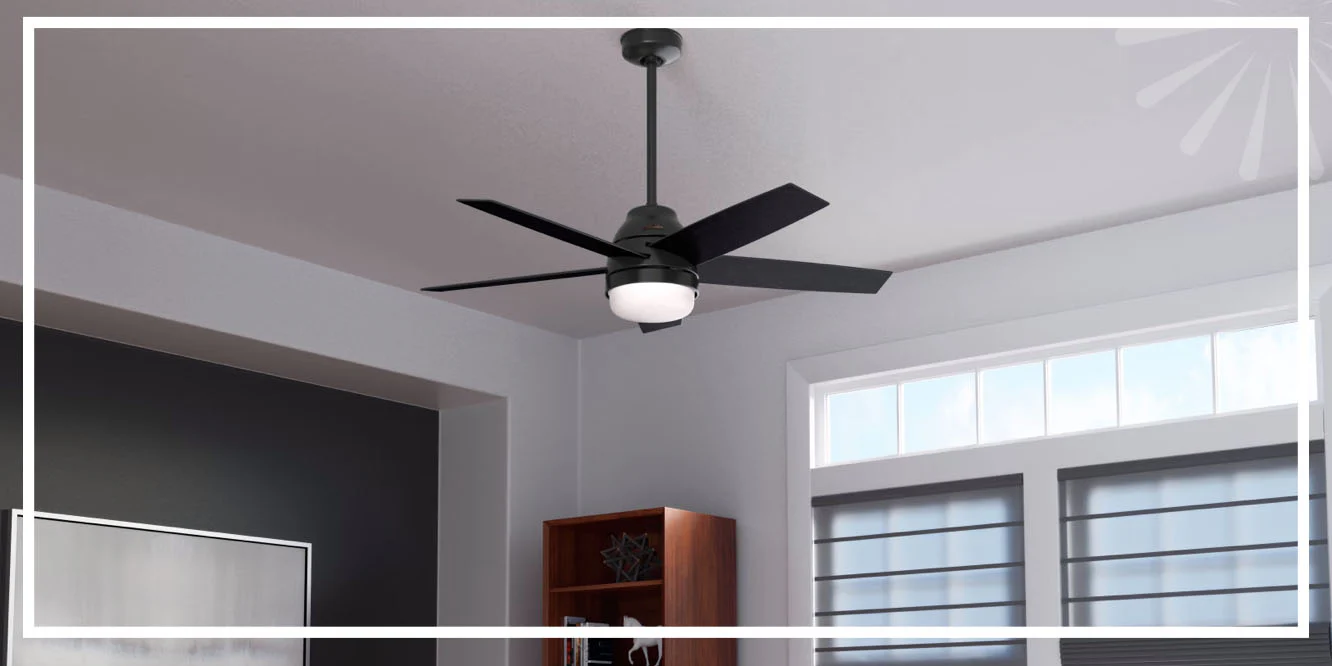
Hunter Skyflow Outdoor with LED Light 52 inch and Wall Control
Hunter Skyflow 52‑in Matte Outdoor Ceiling Fan
A more subdued, modern design: matte finish, sleek blade design, relatively quiet operation. Good balance between performance and visual subtlety. Ideal for modern or minimalist exteriors, or where you want the fan to blend in rather than stand out.
Use‑cases: what problems designer outdoor fans solve and why people need them
Outdoor heat and discomfort
One of the biggest challenges in many climates is uncomfortable heat outdoors, especially during midday or early evenings. Designer outdoor fans help by moving air—creating cooling through evaporation and convection—making patios, decks or outdoor dining areas usable even during hotter times. People in warm or humid climates will especially appreciate that a good outdoor fan reduces heat build‐up without requiring air conditioning.
Protecting against pests and increasing outdoor time
If you have insects that make outdoor leisure difficult (mosquitoes, flies, etc.), moving air is one of the best non‑chemical methods to discourage them. A designer outdoor fan solves this by creating steady airflow. That means more time spent outside, whether for meals, reading, entertainment, or relaxing, without bugs interfering.
Style mismatches or décor awkwardness
Often outdoor fans are basic and utilitarian, and yet outdoor spaces are visible and important parts of home design. A standard fan may look out of place. A designer outdoor fan solves this by matching finishes, blade styles, lighting, and even blade span to your design. This helps the outdoor space feel cohesive with the house, improving both aesthetics and value.
Weather and durability issues
Standard cheap fans outdoors degrade quickly. Rust, fading paint, warped blades, motor issues due to moisture—they are common. Designer outdoor fans are made for the environment: wet/damp ratings, resistant materials (stainless steel, treated wood or composites, sealed motors), and better warranties. So fewer replacements, fewer maintenance hassles.
How to choose, buy, and where to purchase designer outdoor fans
What to check technical specs before buying
-
Rating: wet vs damp vs dry. If exposed directly to rain, pick wet‑rated. If under roof or covered porch, damp rating may suffice.
-
Blade span (diameter): smaller areas need smaller fans; larger open patios need large span (52‑65 in or more) to move sufficient air.
-
Motor type: DC motors are more efficient, quieter, and tend to last longer; AC motors are cheaper but might use more power and produce more noise.
-
Finish and blade material: metals, treated woods, composite plastics. Powder coating and sealed bearings resist rust; UV stability helps prevent fading.
-
Lighting & controls: remote vs wall switch vs smart‑home; LED lighting quality; dimmable or not; color temperature.
-
Warranty & maintenance: good models may offer multi‑year warranties, sometimes for outdoor exposure. Also check replacement part availability.
Where to buy and what price ranges
Designer outdoor fans vary widely in price depending on brand, size, features, and build quality. You’ll find lower‑end designer models around modest budgets (e.g. in Indonesia or localized markets) and high‑end premium marine‑grade or designer‑brand fans in the higher price tiers. Use reputable online stores, specialty lighting/fan shops, or large retailers known for quality products.
Tips for installation & use
-
Ensure proper ceiling height and clearance; for wet‑rated fans, avoid splash zones.
-
Use correct down‑rod length to ensure airflow and clearance.
-
Keep blades clean, finish re‑sealed or protective finishes maintained.
-
When not in use or during storms, cover or protect fan if required by manufacturer.
-
Use speed settings appropriately; lower speeds for comfort, higher speeds for cooling or for insect deterrence.
Summary
A designer outdoor fan is more than just a cooling device—it’s a blend of style, comfort, durability, and efficiency. When you pick a fan that is designed for outdoor conditions (wet/damp rating, resistant materials, good motor), with finishes and design that match your home, you get value in comfort, aesthetics, and peace of mind. Real‑world product examples show what features and price ranges to expect. Before buying, verify your space, specs, and desired features.
Frequently Asked Questions
What is the difference between wet‑rated and damp‑rated outdoor fans?
Wet‑rated fans are built to handle direct exposure to water (rain, heavy humidity, even water spray) with sealed motors, coatings, and components designed for that. Damp‑rated fans are meant for covered outdoor areas where direct water contact is unlikely (under porches, eaves). Using a damp‑rated fan in a wet situation will shorten its lifespan and could damage it.
How large should the blade span be for good outdoor cooling?
Blade span depends on the area size and ceiling height. Small patios or balconies (say under 150 square feet) may be fine with 42‑ to 52‑inch spans. Larger outdoor decks or big patios might need 60‑inch plus or dual fans to deliver sufficient airflow. Also, ensure sufficient clearance from floor and surrounding structures so airflow is not obstructed.
Are DC motor fans always better than AC motor fans?
DC motors tend to be more energy efficient, quieter, and lighter. They often offer more speed settings, sometimes smoother control, and lower power consumption. But AC motors are generally cheaper, more widely available, and perfectly serviceable if built well. If noise, power usage, and long‑term durability are priorities, DC motor designer outdoor fans are often worth the extra cost.

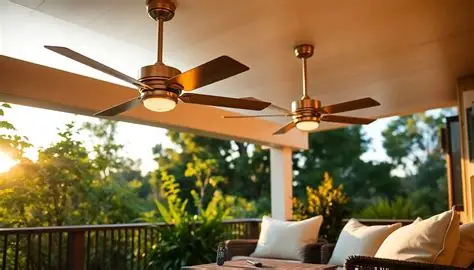
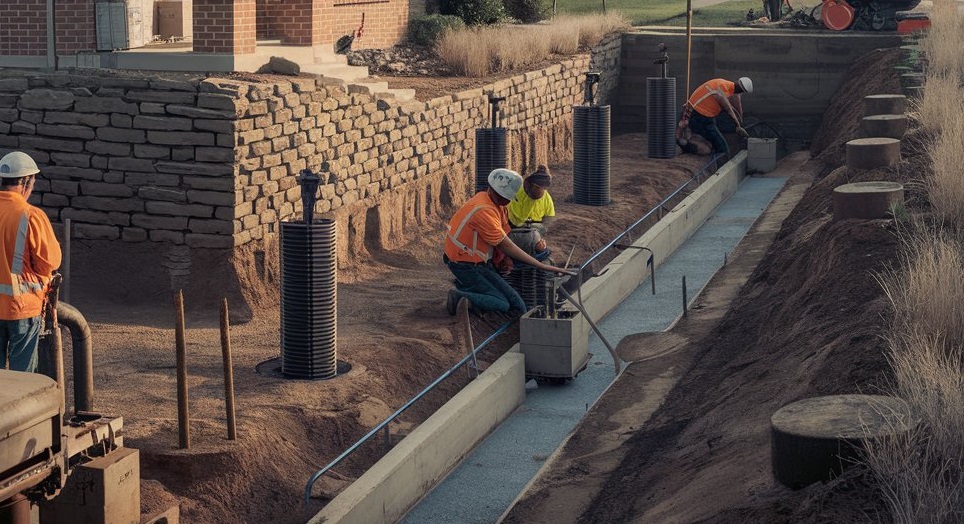
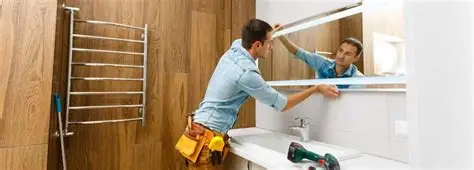


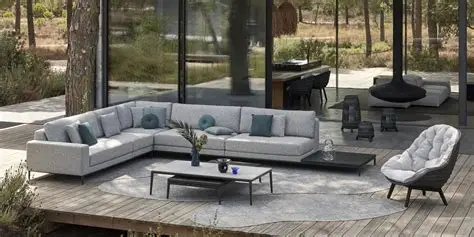

Leave a Reply